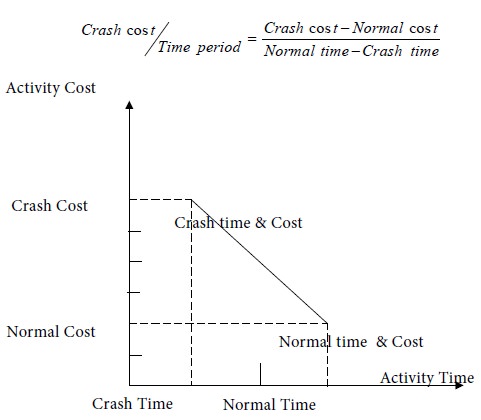Operations Management - Network Problems
The Meaning Of Crashing - Crashing Of A Project
Posted On :
The process of shortening the time to complete a project is called crashing and is usually achieved by putting into service additional labour or machines to one activity or more activities.
The Meaning Of Crashing
The process of shortening the time to complete a project is called crashing and is usually achieved by putting into service additional labour or machines to one activity or more activities. Crashing involves more costs. A project manager would like to speed up a project by spending as minimum extra cost as possible. Project crashing seeks to minimize the extra cost for completion of a project before the stipulated time.
Assumption: It is assumed that there is a linear relationship between time and cost.
Let us consider project crashing by the critical path method. The following four-step procedure is adopted.
Step 1
Find the critical path with the normal times and normal costs for the activities and identify the critical activities.
Step 2
Find out the crash cost per unit time for each activity in the network. This is calculated by means of the following formula.

The process of shortening the time to complete a project is called crashing and is usually achieved by putting into service additional labour or machines to one activity or more activities. Crashing involves more costs. A project manager would like to speed up a project by spending as minimum extra cost as possible. Project crashing seeks to minimize the extra cost for completion of a project before the stipulated time.
Steps In Project Crashing
Assumption: It is assumed that there is a linear relationship between time and cost.
Let us consider project crashing by the critical path method. The following four-step procedure is adopted.
Step 1
Find the critical path with the normal times and normal costs for the activities and identify the critical activities.
Step 2
Find out the crash cost per unit time for each activity in the network. This is calculated by means of the following formula.

Step 3
Select an activity for crashing. The criteria for the selection is as follows:
Select the activity on the critical path with the smallest crash cost per unit time. Crash this activity to the maximum units of time as may be permissible by the given data.
Crashing an activity requires extra amount to be spent. However, even if the company is prepared to spend extra money, the activity time cannot be reduced beyond a certain limit in view of several other factors.
In step 1, we have to note that reducing the time of on activity along the critical path alone will reduce the completion time of a project. Because of this reason, we select an activity along the critical path for crashing. In step 3, we have to consider the following question:
If we want to reduce the project completion time by one unit, which critical activity will involve the least additional cost?
On the basis of the least additional cost, a critical activity is chosen for crashing. If there is a tie between two critical activities, the tie can be resolved arbitrarily.
Step 4
Select an activity for crashing. The criteria for the selection is as follows:
Select the activity on the critical path with the smallest crash cost per unit time. Crash this activity to the maximum units of time as may be permissible by the given data.
Crashing an activity requires extra amount to be spent. However, even if the company is prepared to spend extra money, the activity time cannot be reduced beyond a certain limit in view of several other factors.
In step 1, we have to note that reducing the time of on activity along the critical path alone will reduce the completion time of a project. Because of this reason, we select an activity along the critical path for crashing. In step 3, we have to consider the following question:
If we want to reduce the project completion time by one unit, which critical activity will involve the least additional cost?
On the basis of the least additional cost, a critical activity is chosen for crashing. If there is a tie between two critical activities, the tie can be resolved arbitrarily.
Step 4
After crashing an activity, find out which is the critical path with the changed conditions. Sometimes, a reduction in the time of an activity in the critical path may cause a non-critical path to become critical. If the critical path with which we started is still the longest path, then go to Step 3. Otherwise, determine the new critical path and then go to Step 3.
Tags : Operations Management - Network Problems
Last 30 days 1303 views












